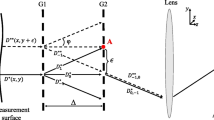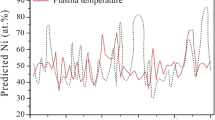Abstract
Background
Metal additive manufacturing has extensive application prospects in the aerospace, precision instrument, and biomedical fields, etc. However, the low manufacturing quality of key components is a bottleneck restricting the further development and application of this technology. Because of the extremely complex manufacturing environment, a real-time and online monitoring technology for the manufacturing quality remains lacking.
Objective
For laser engineered net shaping (LENS), a mainstream technology of metal additive manufacturing, a hybrid method for the online evaluation of stress fields during laser cladding is developed in this paper that combines the real-time measured temperature field, three-dimensional deformation field and finite element method.
Methods
The proposed method first designed the synchronous measurement optical paths of the temperature field and three-dimensional deformation field of the substrate, and the positions of the temperature and deformation field images were matched. A finite element model was established based on the printing parameters such as the layer thickness and printing speed, and the temperature field and three-dimensional deformation field synchronously measured at each moment were incorporated into the model as boundary conditions to obtain the deformation and stress information inside the model.
Results
We compared the stress field obtained at the end of printing with the XRD (X-ray diffraction) measurement results to verify the effectiveness of the proposed method. The proposed method can obtain the three-dimensional stress distribution and evolution of the substrate and printed component.
Conclusion
The proposed method can realize the online characterization of the three-dimensional stress field in the LENS printing process and provide important experimental guidance and data for the quality control of 3D printing.










Similar content being viewed by others
References
Edgar J, Tint S (2015) Additive manufacturing technologies: 3D printing, rapid prototyping, and direct digital manufacturing. Johnson Matthey Technology Review 59(3): 193–198. https://doi.org/10.1595/205651315X688406
Basso li E, Gatto A, Iuliano L, Grazia Violante, (2007) 3D printing technique applied to rapid casting. Rapid Prototyp J 1(3):148–155. https://doi.org/10.1108/13552540710750898
Lam CXF, Mo X, Teoh SH, Hutmacher D (2002) Scaffold development using 3D printing with a starch-based polymer. Mater Sci Eng C 20:49–56. https://doi.org/10.1016/S0928-4931(02)00012-7
Lipson H (2013) Fabricated: The new world of 3D printing. John Wiley & Sons
Murphy SV, Atala A (2014) 3D bioprinting of tissues and organs. 32(8): 773–785. https://doi.org/10.1038/nbt.2958
Melcher R, Martins S, Travitzky N (2006) Fabrication of Al2O3-based composites by indirect 3D-printing. Mater Lett 60(4):572–575. https://doi.org/10.1016/j.matlet.2005.09.059
Herrmann KH (2014) 3D printing of MRI compatible components: Why every MRI research group should have a low-budget 3D printer. Med Eng Phys 36(10):1373–1380. https://doi.org/10.1016/j.medengphy.2014.06.008
Balla VK, DeVasConCellos PD, Xue W (2009) Fabrication of compositionally and structurally graded Ti–TiO2 structures using laser engineered net shaping (LENS). Acta Biomater 5(5):1831–1837. https://doi.org/10.1016/j.actbio.2009.01.011
Abd-Elghany K, Bourell DL (2012) Property evaluation of 304L stainless steel fabricated by selective laser melting. Rapid Prototyp J 18(5):420–428. https://doi.org/10.1108/13552541211250418
Brückner F, Lepski D, Beyer E (2007) Modeling the influence of process parameters and additional heat sources on residual stresses in laser cladding. J Therm Spray Technol 16(3):355–373. https://doi.org/10.1007/s11666-007-9026-7
Schmaltz K, Zarzalejo L, Amon CH (1999) Molten droplet solidification and substrate remelting in microcasting Part II: Parametric study and effect of dissimilar materials. Heat Mass Transf 35(1):17–23. https://doi.org/10.1007/s002310050293
Zhou S, Zeng, X Hu, Q Huang. (2008) Analysis of crack behavior for Ni-based WC composite coatings by laser cladding and crack-free realization. 255(5p1): 1646–1653. https://doi.org/10.1016/j.apsusc.2008.04.003
Xu JS, Zhang XC, Xuan FZ (2013) Tensile properties and fracture behavior of laser cladded WC/Ni composite coatings with different contents of WC particle studied by in-situ tensile testing 560:744–751. https://doi.org/10.1016/j.msea.2012.10.028
Dubois M, Militzer M, Moreau A (2000) A new technique for the quantitative real-time monitoring of austenite grain growth in steel. Scr Mater 42(9):867–874. https://doi.org/10.1016/S1359-6462(00)00305-5
Heigel J C, Lane B M, Levine L E. (2020) In situ measurements of melt-pool length and cooling rate during 3D builds of the metal AM-bench artifacts [J]. Integr Mater Manuf Innov 9(1): 31–53. https://doi.org/10.1007/s40192-020-00170-8
Lane B, Heigel J, Ricker R (2020) Measurements of melt pool geometry and cooling rates of individual laser traces on IN625 bare plates [J] Integr Mater Manuf Innov 1–15 https://doi.org/10.1007/s40192-020-00169-1
Zheng L, Zhang Q, Cao H (2019) Melt pool boundary extraction and its width prediction from infrared images in selective laser melting [J]. Mater Des 183:108110. https://doi.org/10.1016/j.matdes.2019.108110
Bernhard R, Neef P, Wiche H (2020) Defect detection in additive manufacturing via a toolpath overlaid melt-pool-temperature tomography [J]. J Laser Appl 32(2): 022055. https://doi.org/10.2351/7.0000055
Bisht M, Ray N, Verbist F, et al (2018) Correlation of selective laser melting-melt pool events with the tensile properties of Ti-6Al-4V ELI processed by laser powder bed fusion [J]. Addit Manuf. 22: 302–306. https://doi.org/10.1016/j.addma.2018.05.004
Tapia G, Elwany A (2014) A review on process monitoring and control in metal-based additive manufacturing. J Manuf Sci Eng 136(6): 060801. https://doi.org/10.1115/1.4028540
Shiomi M (2004) Residual stress within metallic model made by selective laser melting process. CIRP Ann 1(53):195–198. https://doi.org/10.1016/S0007-8506(07)60677-5
Belle LV, Vansteenkiste G (2013) Investigation of Residual Stresses Induced during the Selective Laser Melting Process Key Eng Mater 554–557 2 1828 1834 https://doi.org/10.4028/www.scientific.net/KEM.554-557.1828
Yakout M , Elbestawi M A , Veldhuis S C (2020) A study of the relationship between thermal expansion and residual stresses in selective laser melting of Ti-6Al-4V[J]. J Manuf Process 52:181–192. https://doi.org/10.1016/j.jmapro.2020.01.039
Wang L, Jiang X, Zhu Y (2018) An approach to predict the residual stress and distortion during the selective laser melting of AlSi10Mg parts[J]. Int J Adv Manuf Technol. https://doi.org/10.1007/s00170-018-2207-3
Krauss H , Zeugner T , Zaeh M F (2014) Layerwise Monitoring of the Selective Laser Melting Process by Thermography[J]. Phys Procedia 56: 64–71. https://doi.org/10.1016/j.phpro.2014.08.097
Yang X, Liu Z, Xie H (2012) A real time deformation evaluation method for surface and interface of thermal barrier coatings during 1100 C thermal shock. Meas Sci Technol 23(10): 105604. https://doi.org/10.1088/0957-0233/23/10/105604
Acknowledgements
This work was financially supported by the National Key Research and Development Program of China (Grant No.2017YFB1103900), National Natural Science Foundation of China(11972084),National Science and Technology Major Project (2017-VI-0003-0073),Beijing Institute of Spacecraft Environment Engineering (CAST-BISEE2019-010), and Beijing Natural Science Foundation (1192014).
Author information
Authors and Affiliations
Corresponding author
Ethics declarations
Conflict of Interest
The authors have no conflicts of interest to declare.
Additional information
Publisher's Note
Springer Nature remains neutral with regard to jurisdictional claims in published maps and institutional affiliations.
Rights and permissions
About this article
Cite this article
Zeng, G.Z., Zu, R.L., Wu, D.L. et al. A Hybrid Method for the Online Evaluation of Stress Fields in Metal Additive Manufacturing. Exp Mech 61, 1261–1270 (2021). https://doi.org/10.1007/s11340-021-00735-4
Received:
Accepted:
Published:
Issue Date:
DOI: https://doi.org/10.1007/s11340-021-00735-4




